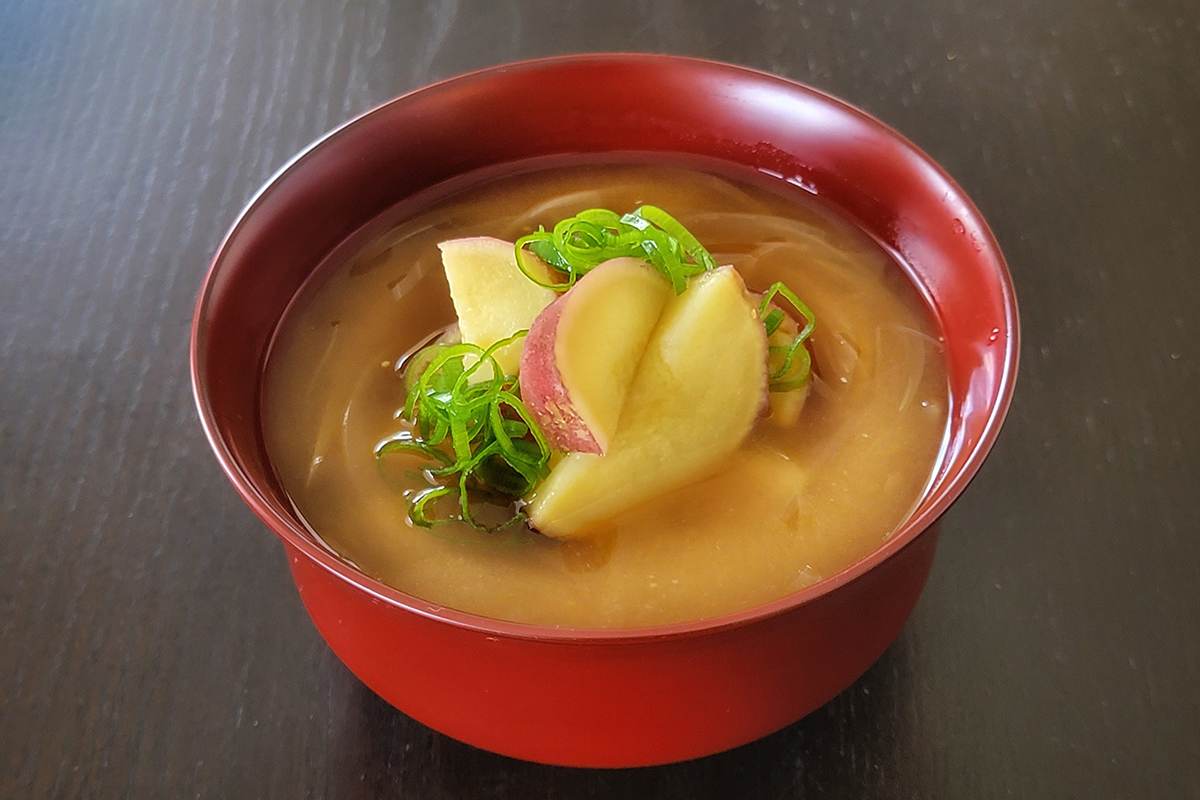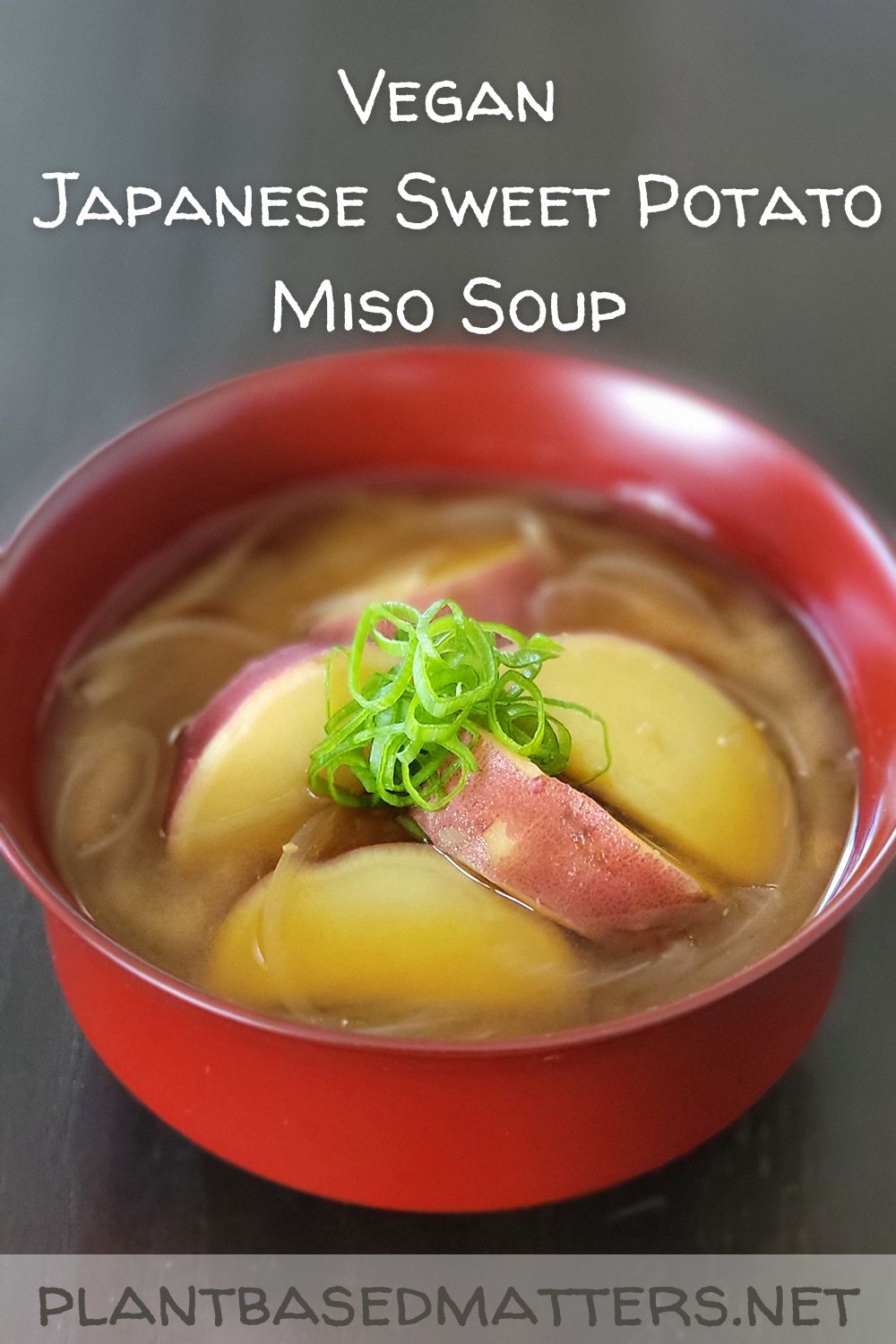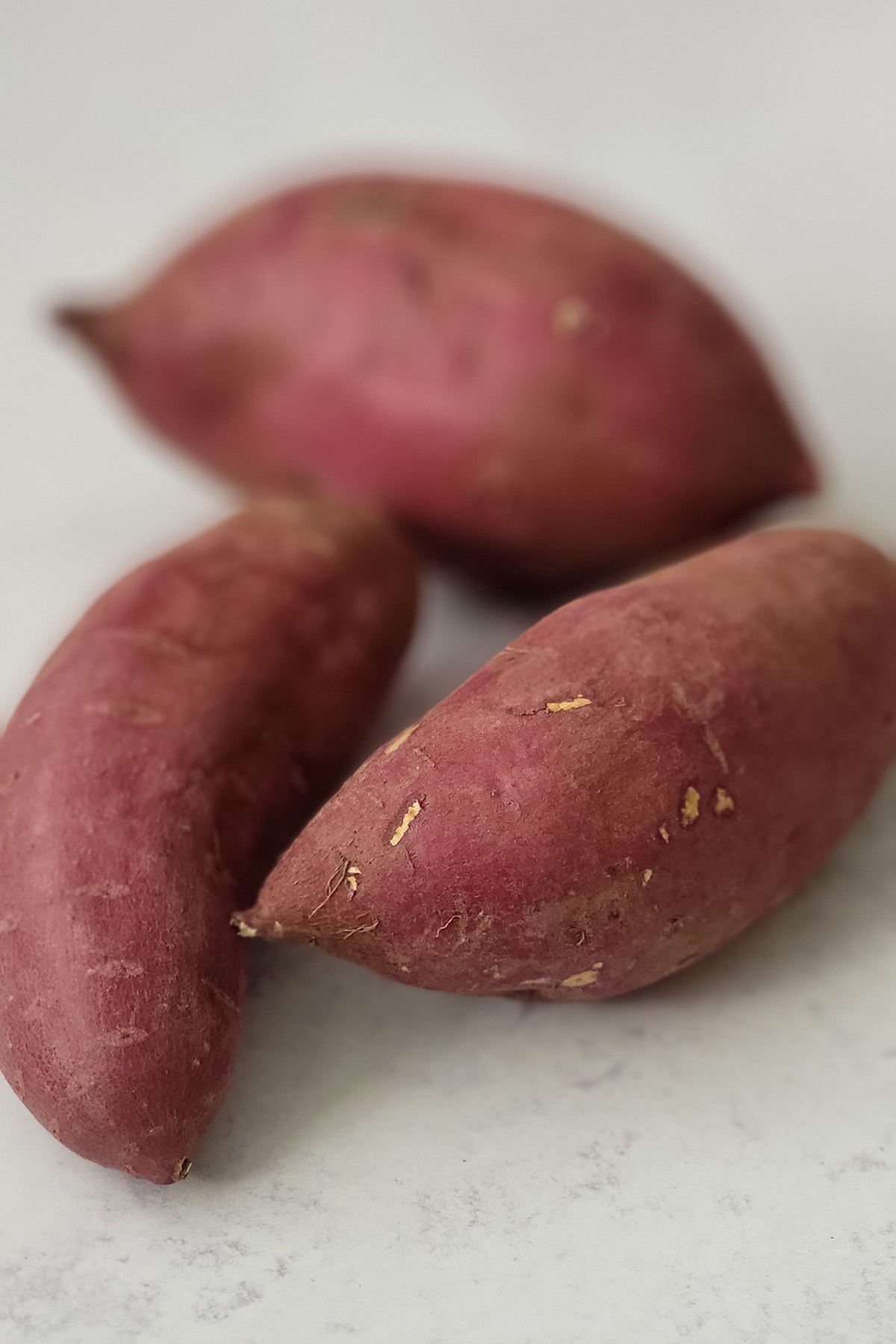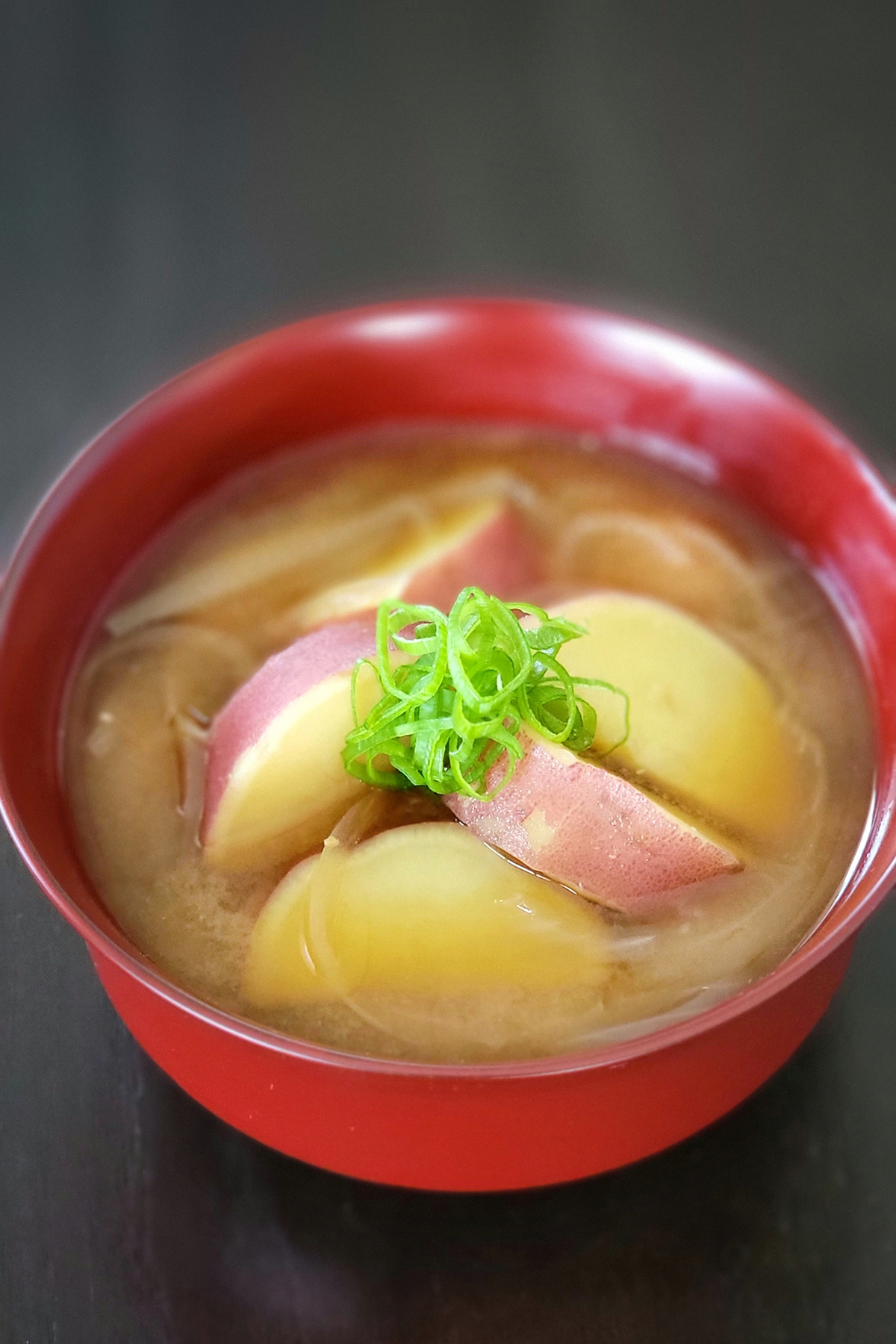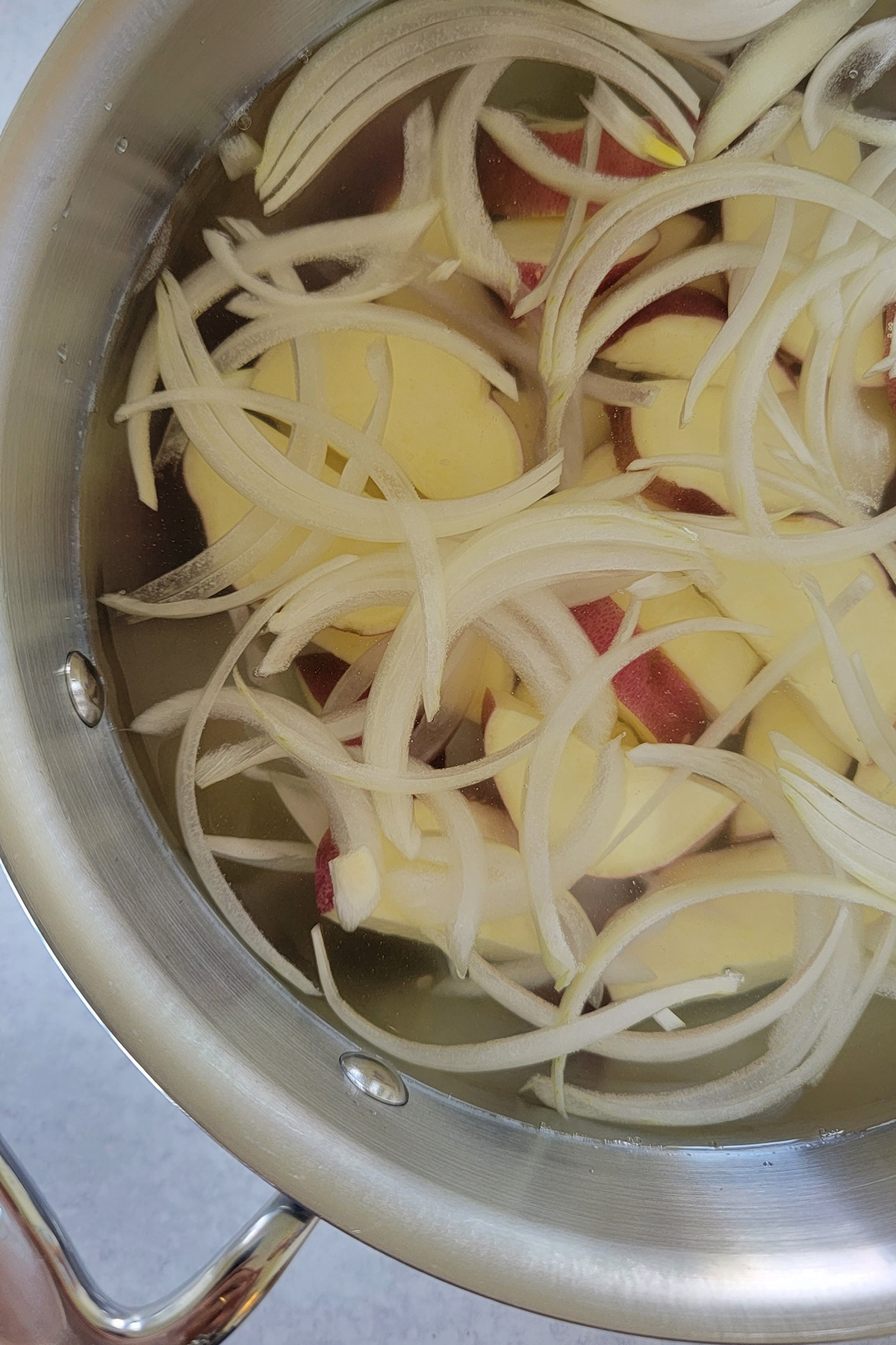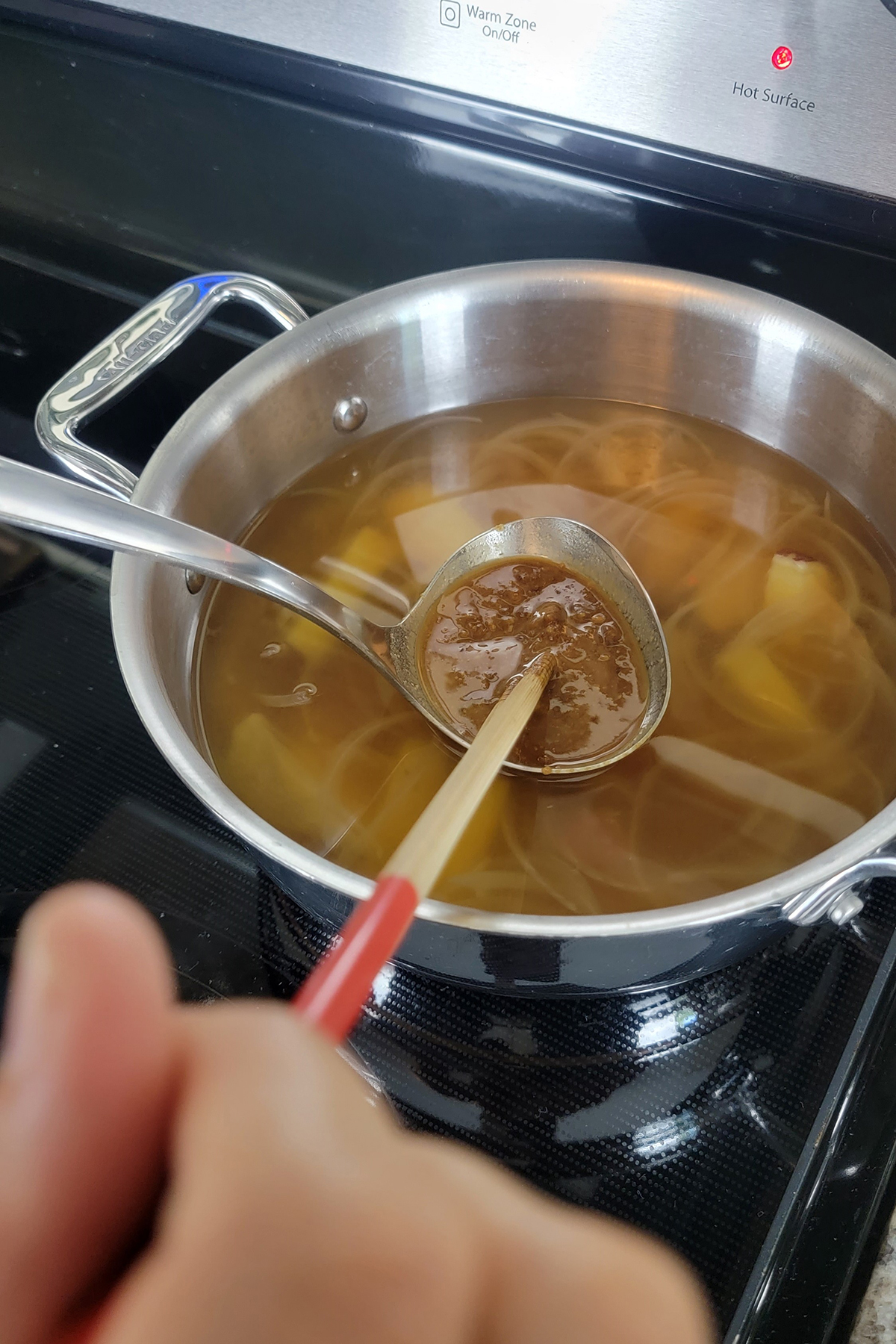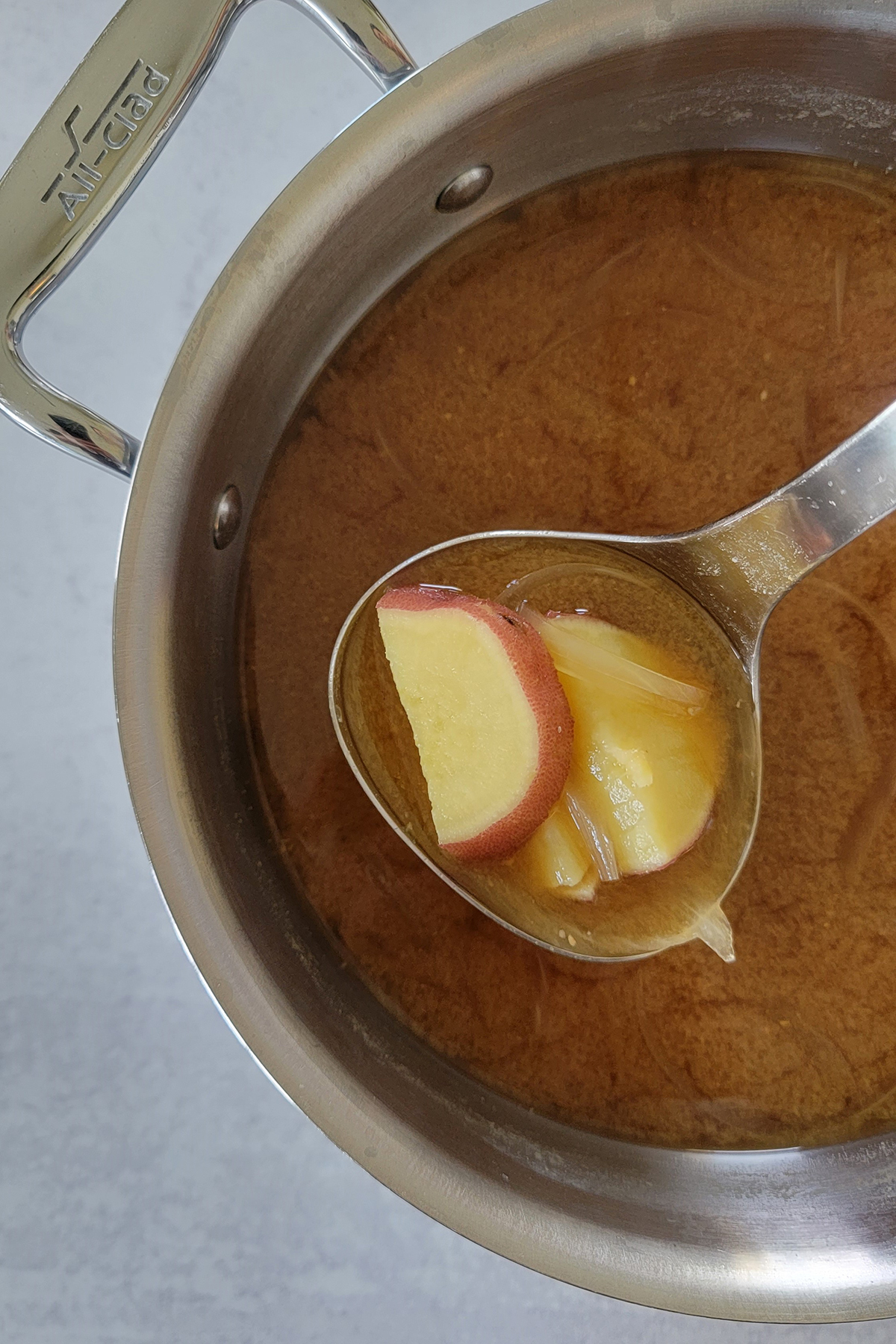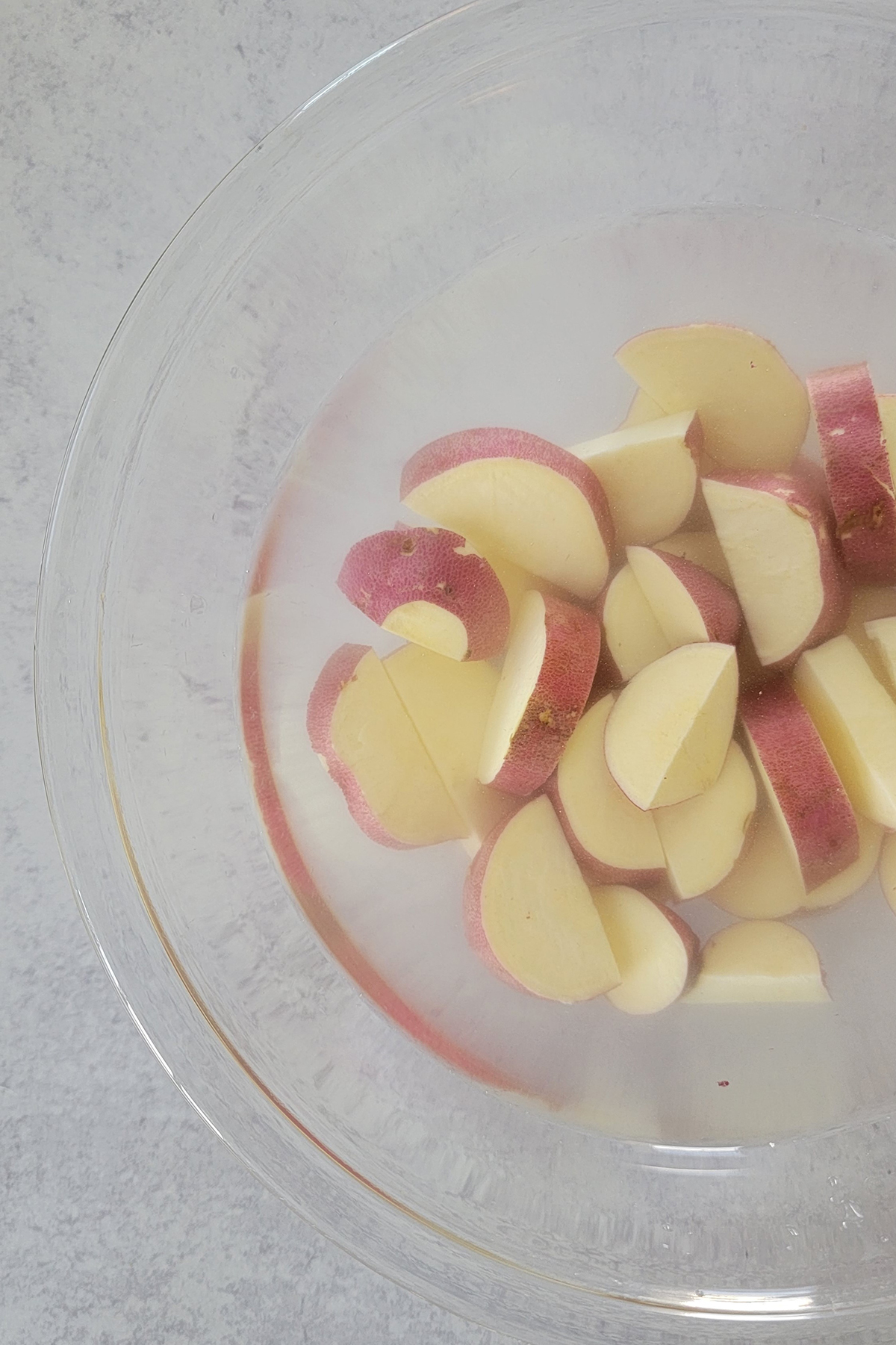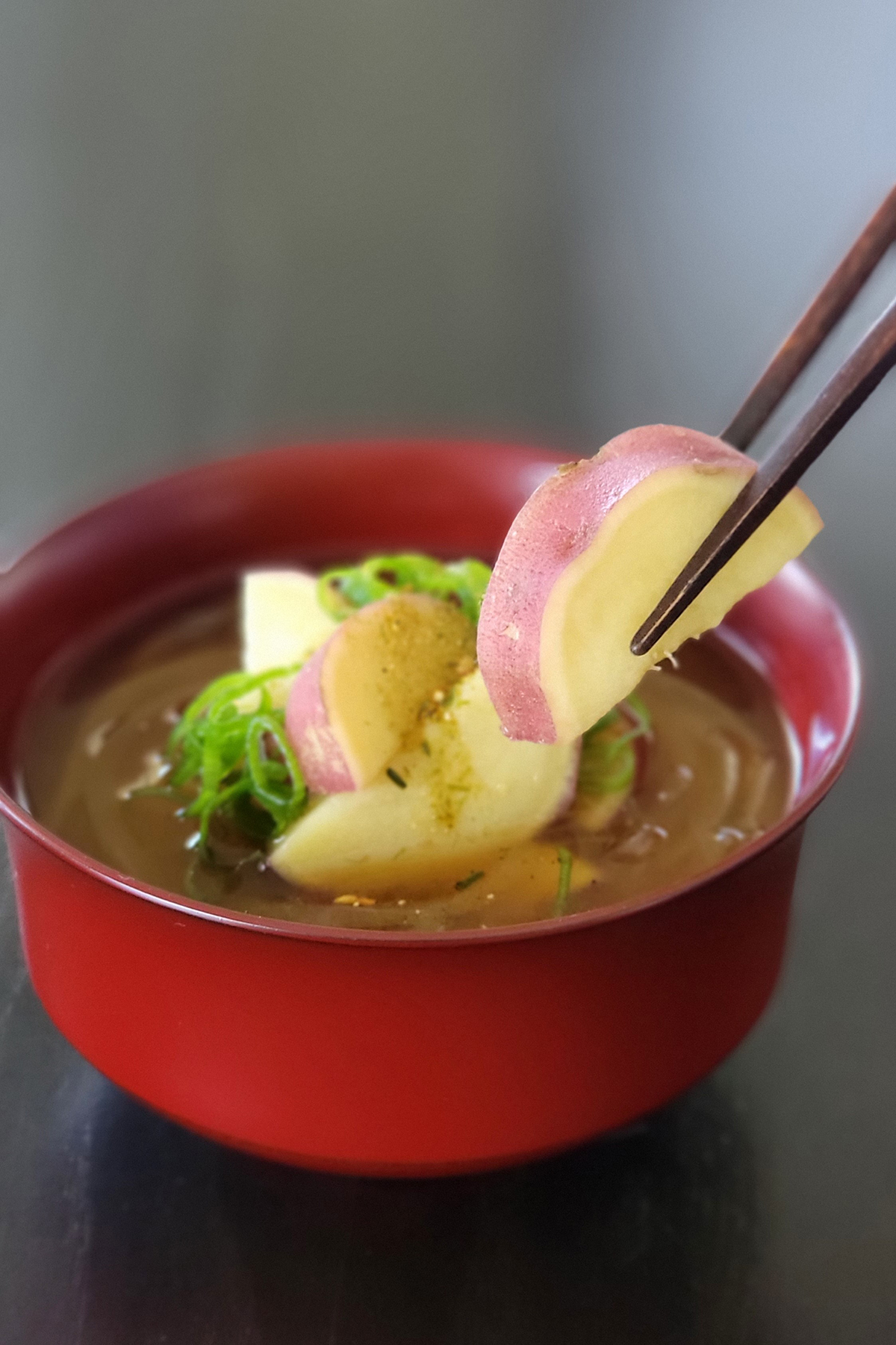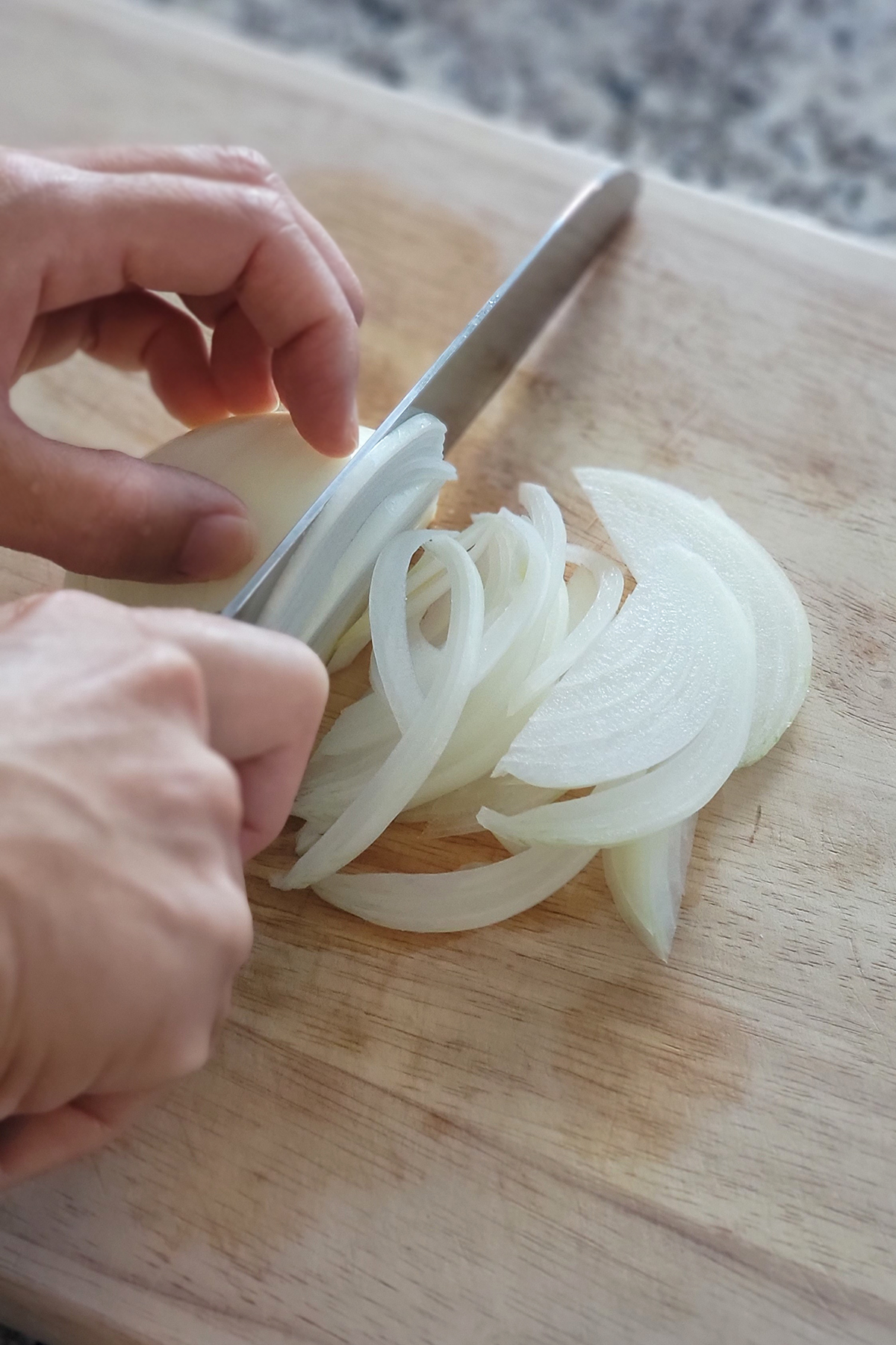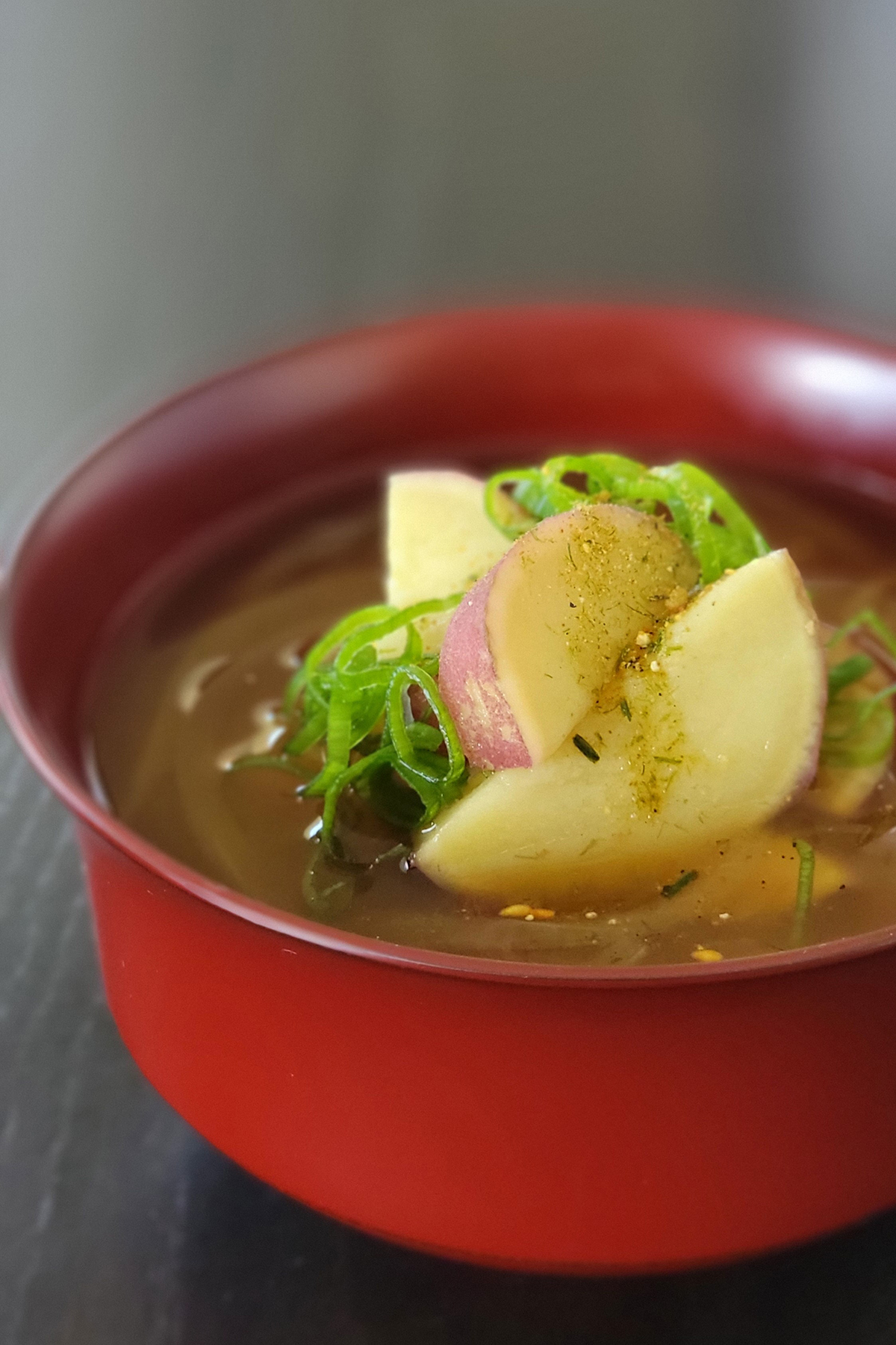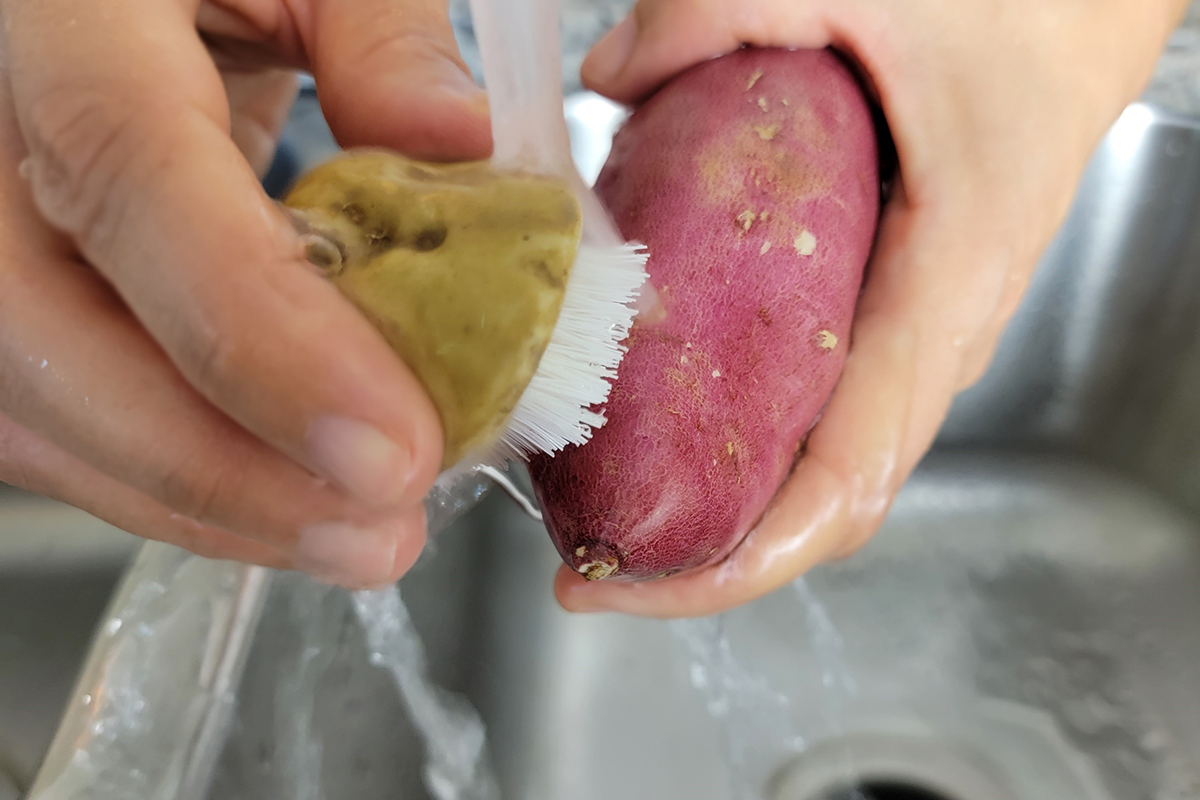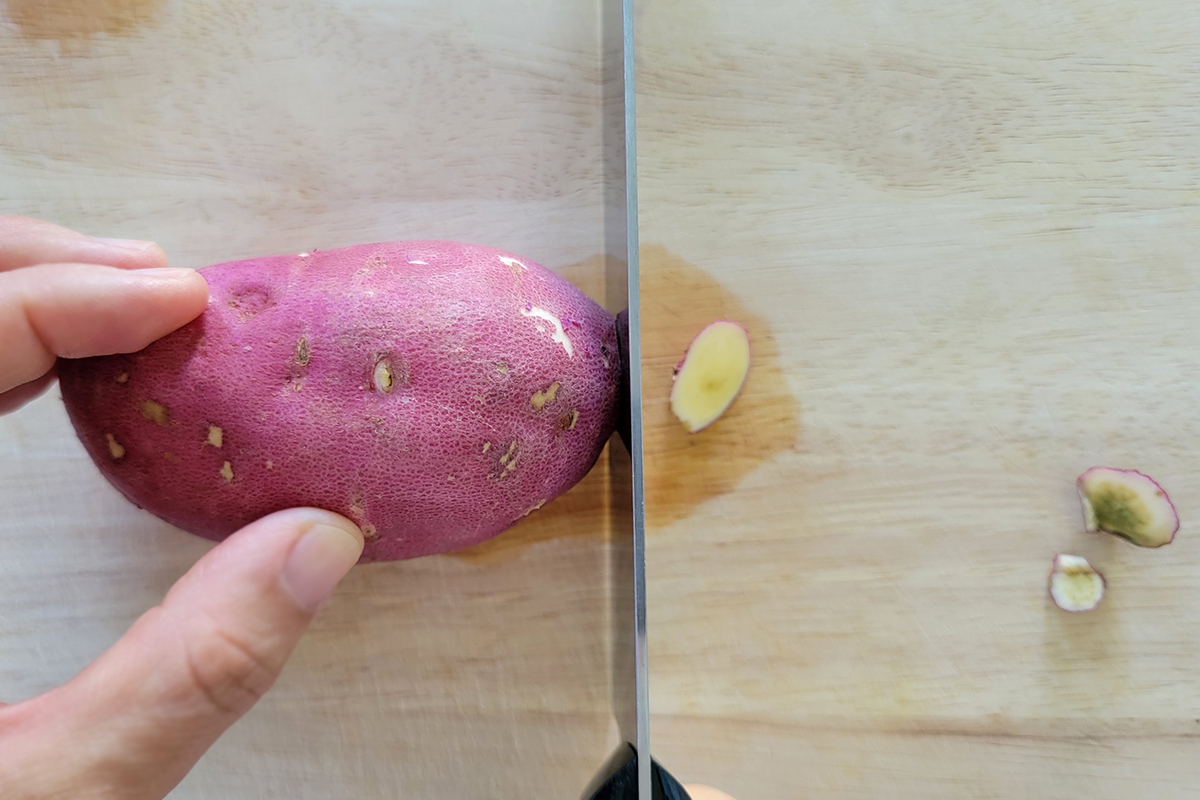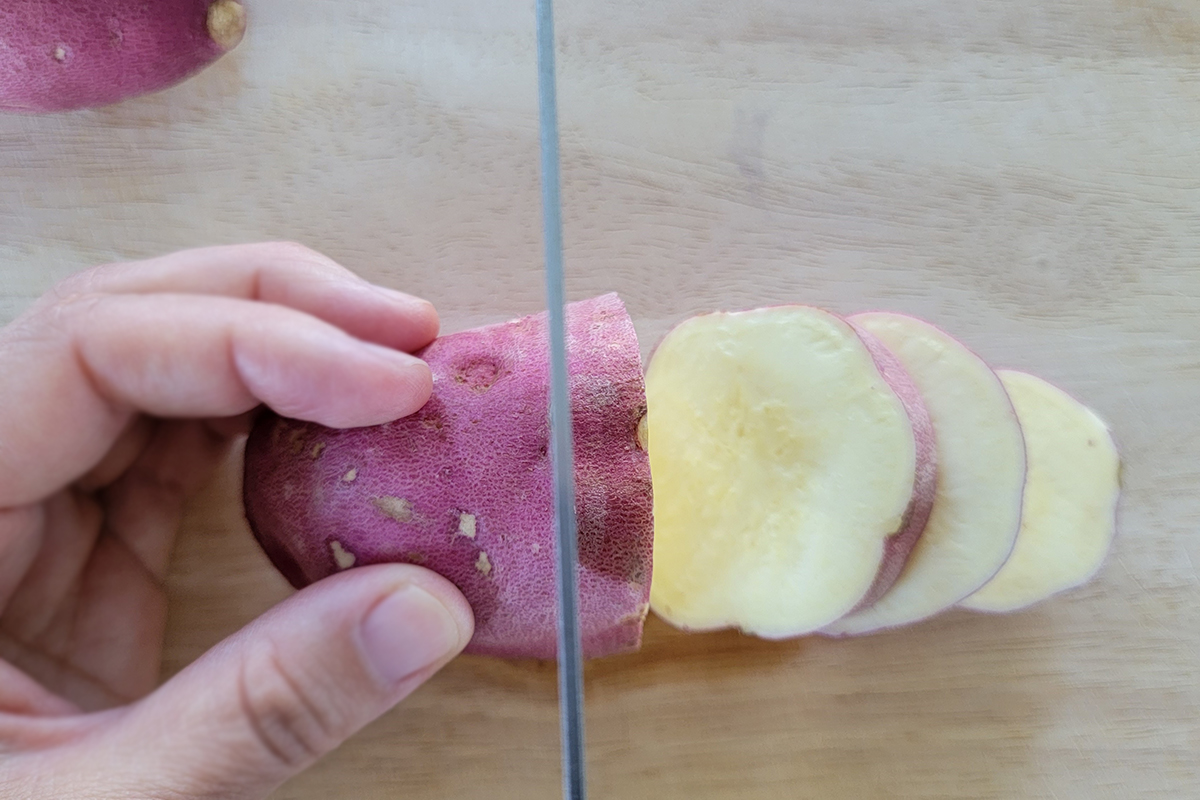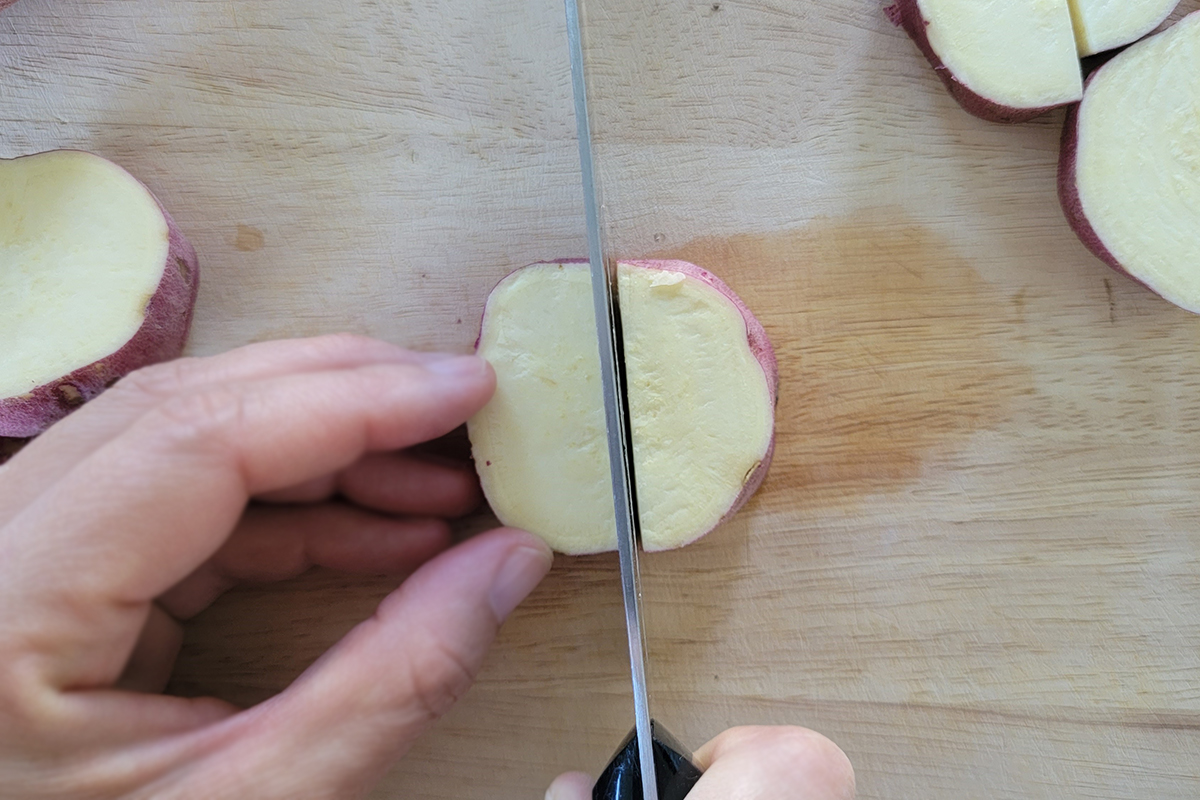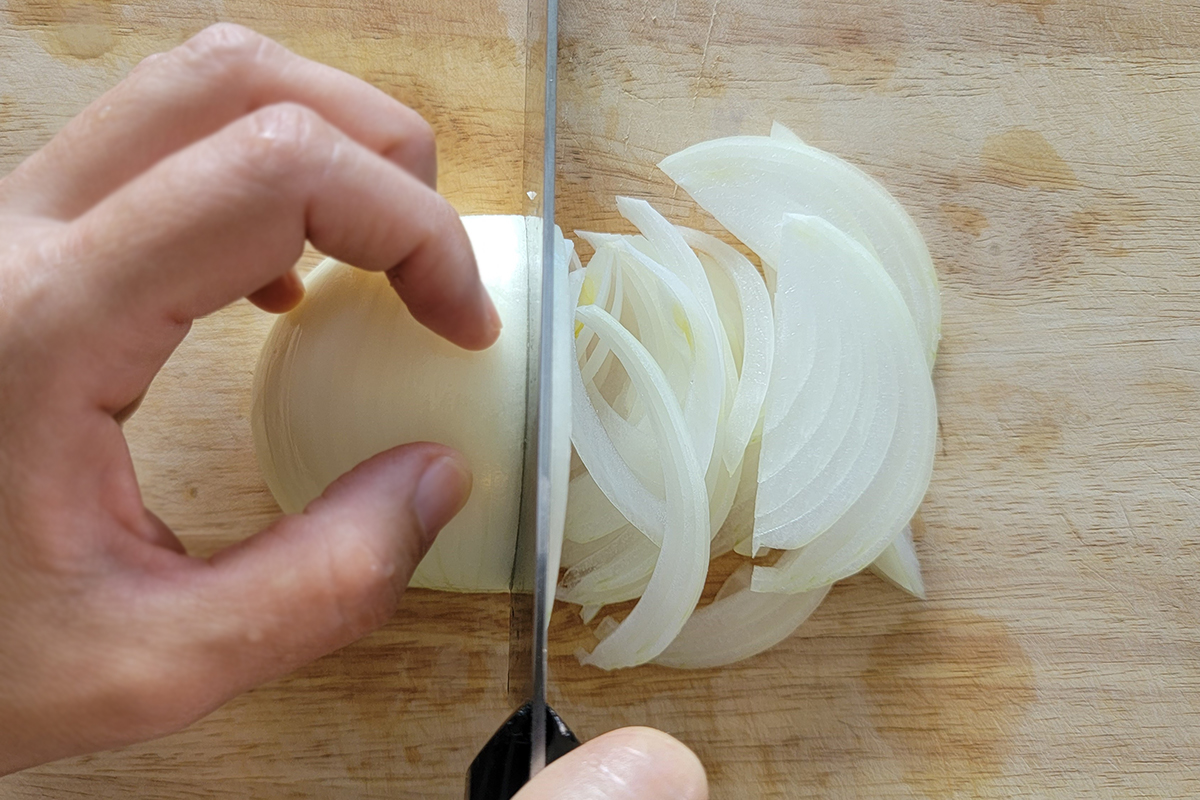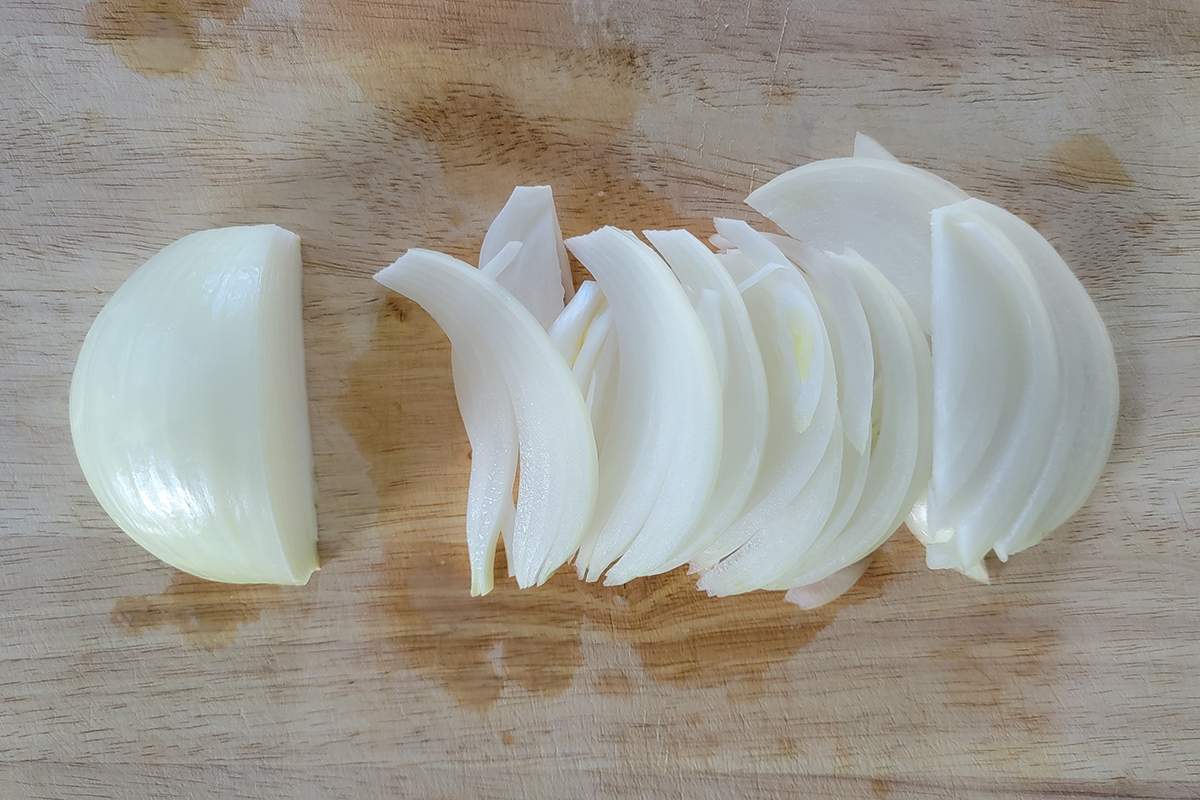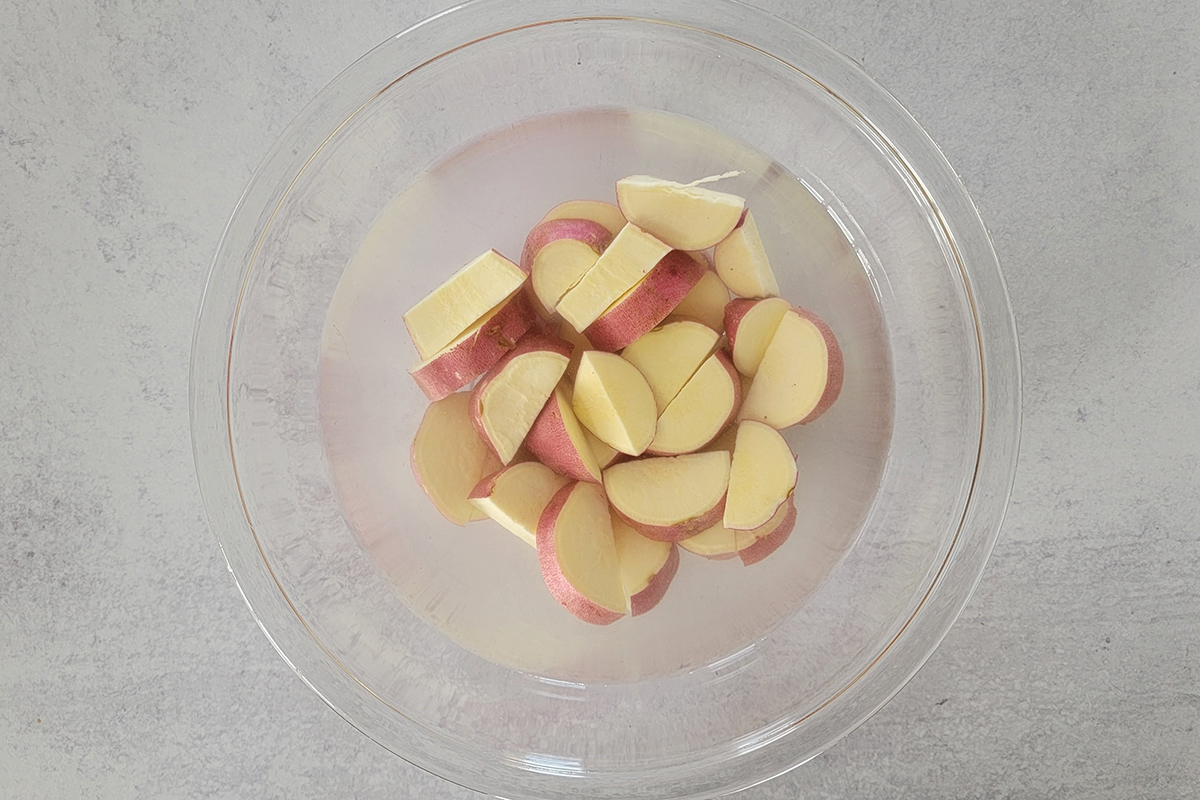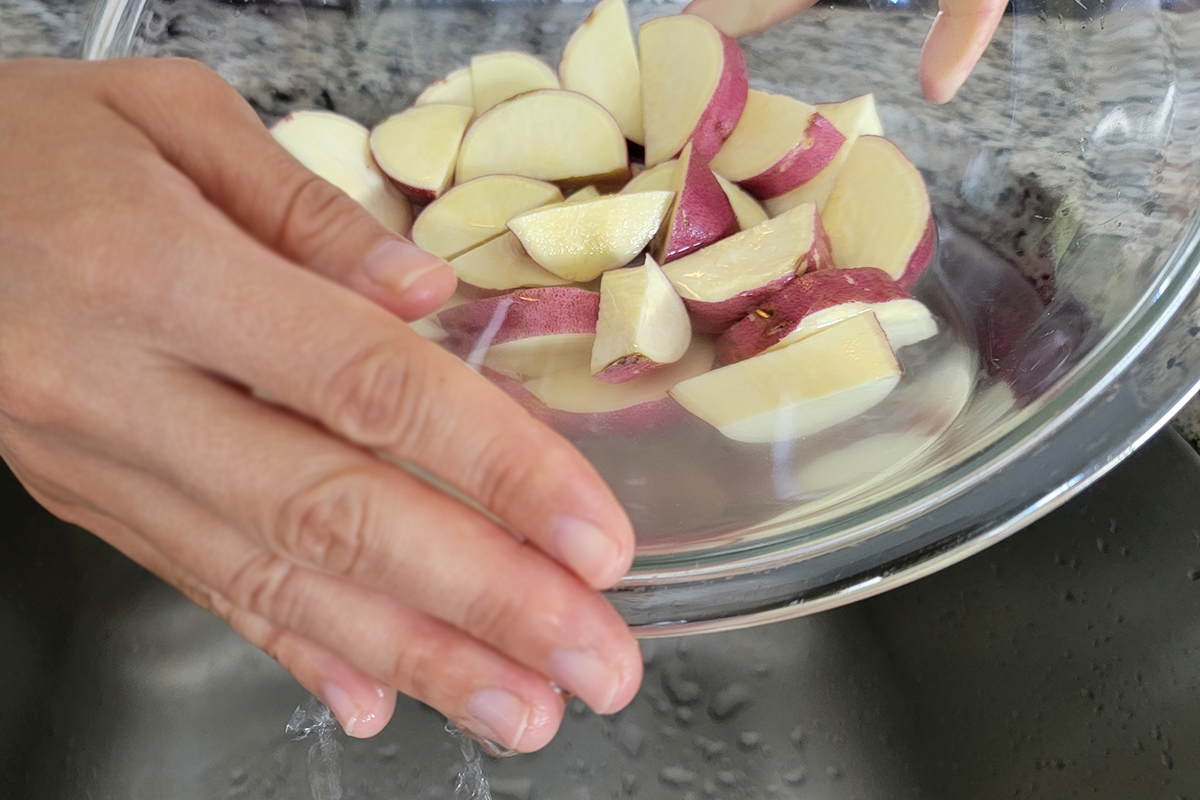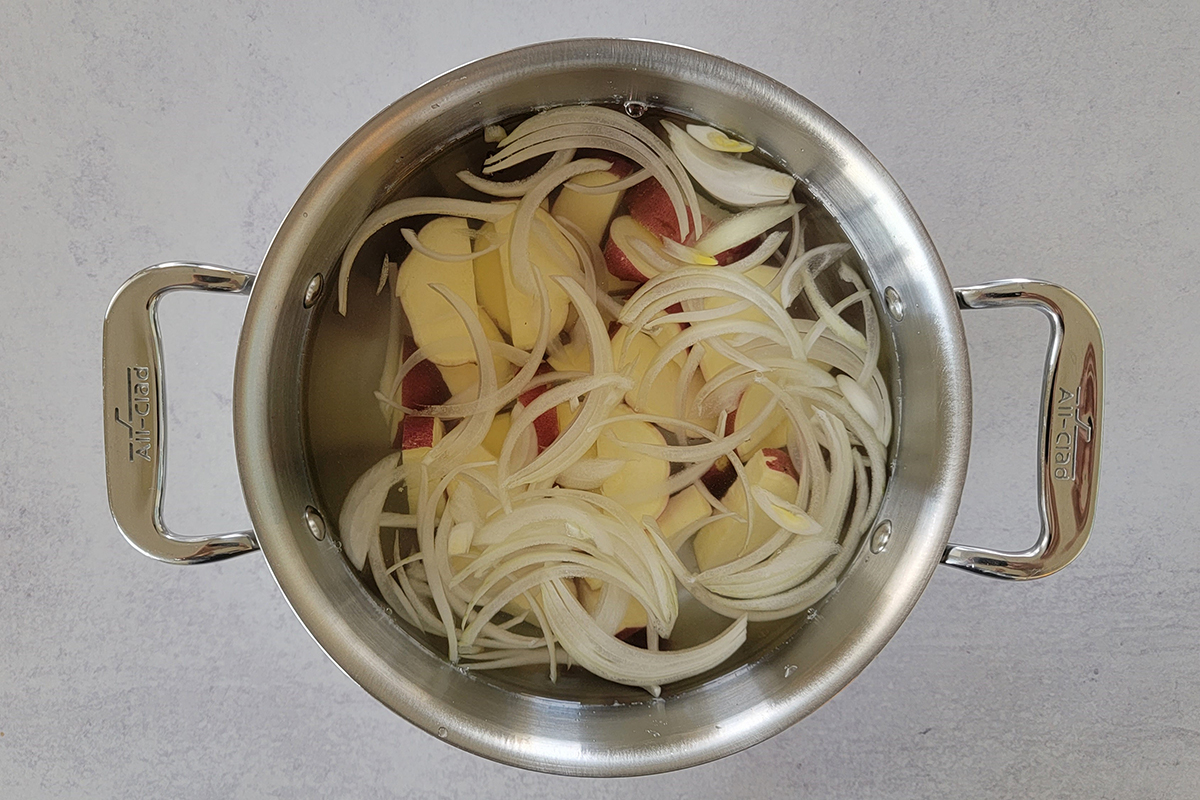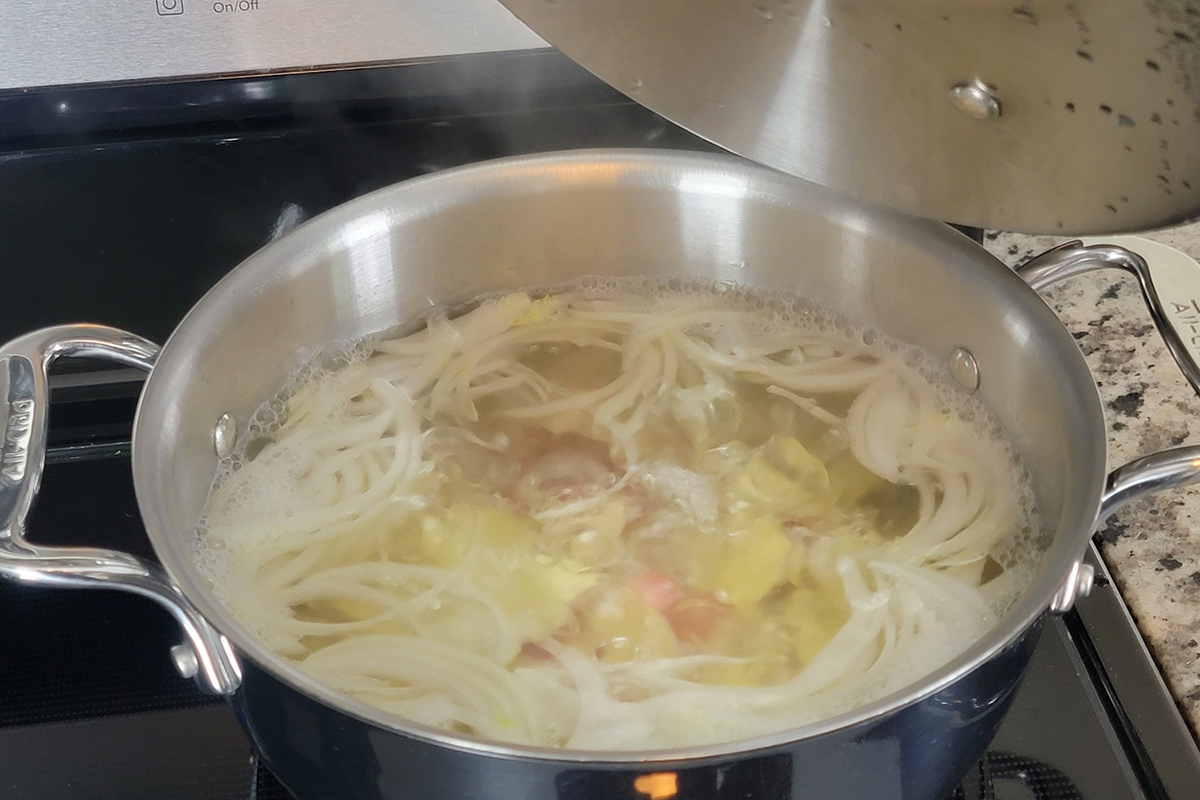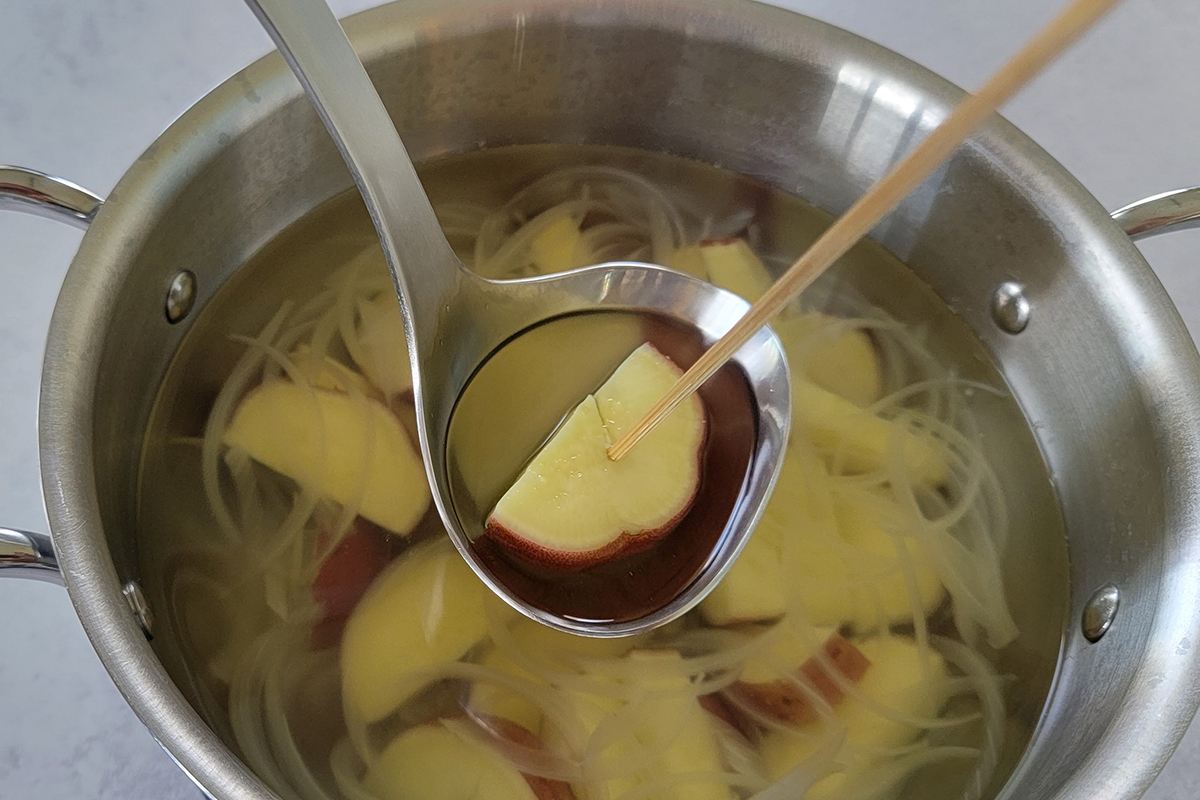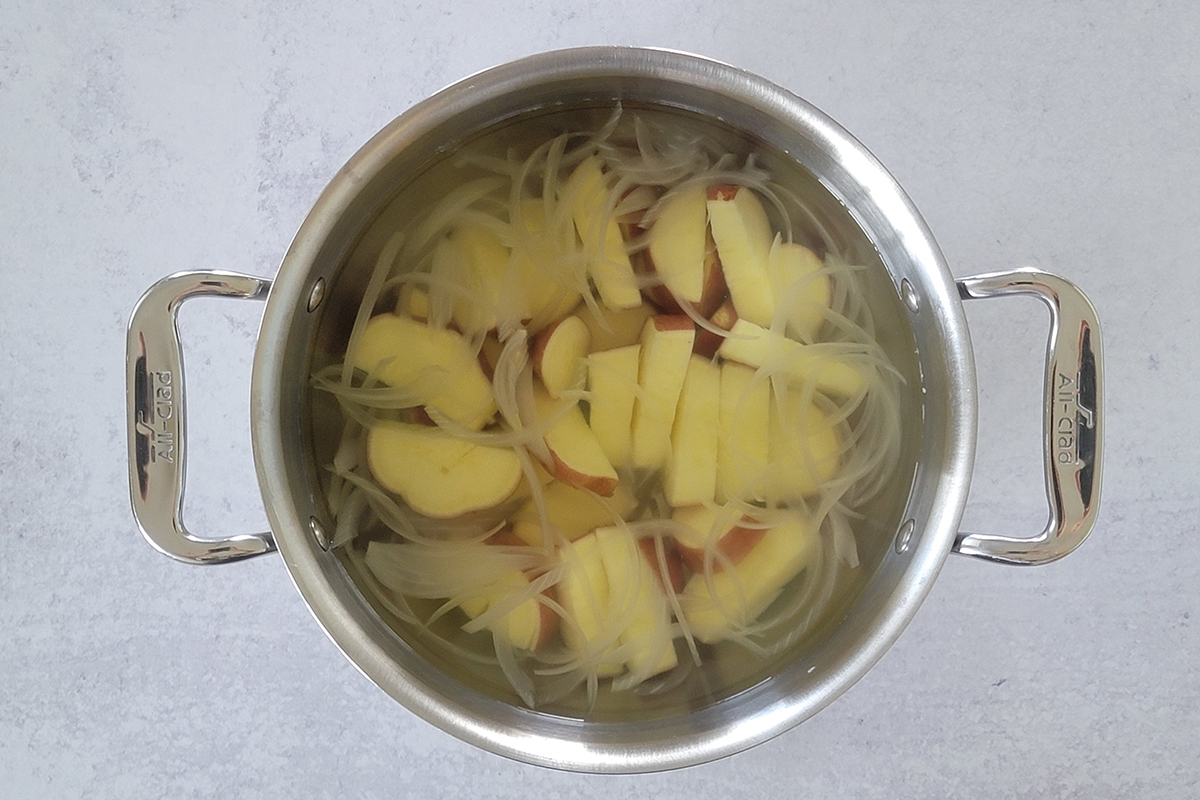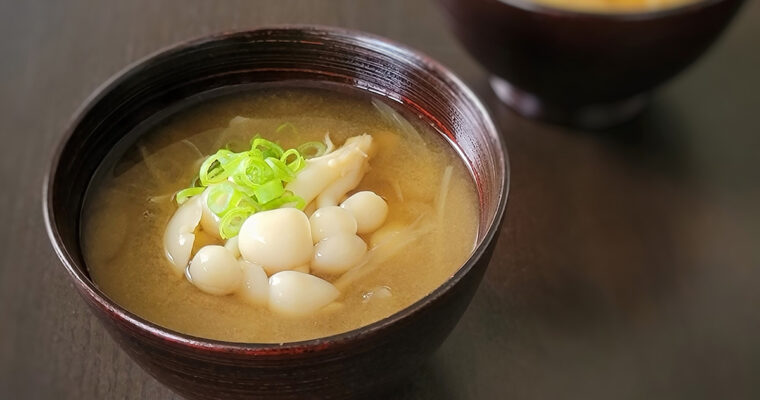Last Updated on October 7, 2022
[ヴィーガンさつま芋のお味噌汁]
This sweet and savory Vegan Japanese Sweet Potato Miso Soup is a taste of fall in Japan but prepared without the traditional bonito and kombu dashi! It only takes 5 ingredients to make but the flavors are very comforting and complex: savory, umami-rich and naturally sweet! The steps are also very simple and easy to follow, so cooks at any level can enjoy making this authentic Japanese recipe. This is one of my favorite miso soups that I make in fall.
Japanese Sweet Potato
I must say Japanese sweet potatoes are the sweetest one out of all from the sweet potato categories.
Japanese sweet potato has red/purple thin skin with pale yellow flesh. When you roast them in the oven or open fire, the sweetness intensifies where you can eat as is for a healthy whole food sweet snack. Our two beagles, Red and Haylie (my sous chefs), love the oven-roasted Japanese sweet potatoes!
In Japan, sweet potato is definitely a seasonal ingredient, autumn or fall to be specific. Here in the US, you may be able to find them throughout the year however, it tastes way better (sweeter) when it’s in the season!
When the fall arrives in Japan, we adore the season with the Japanese sweet potatoes along with other seasonal harvest like mushrooms. I still remember harvesting some sweet potatoes when I went on a elementary school field trip. I would take them home and my mom steamed them. With a drop of butter, oh my god, it was super sweet and comforting.
Fast forward, in my adult life, my go-to Japanese sweet potato dishes are Japanese sweet potato rice and this vegan Japanese sweet potato miso soup!
Taste of Vegan Japanese Sweet Potato Miso Soup
What I really like about the taste of the vegan Japanese sweet potato miso soup is both sweet & savory!
Sweet and savory is an iconic taste in Japanese cooking. In this recipe, the natural sweetness of the sweet potato and onion are steeped into the soup. It’s not overly sweet but you can taste just a hint of sweetness in the background when you sip the soup.
Not to mention, the savory taste of miso with the umami element complements and balances the sweetness.
No Dashi Vegan Miso Soup
Traditionally, miso soup is not vegan due to the dashi made with bonito. As a vegan substitute, I typically use kombu dashi or kombu & shiitake dashi to give a good basic flavor to the soup….but, not for this Japanese sweet potato miso soup!
You may be thinking how flavorful this can be without any use of dashi stock.
Believe it or not, there are certain ingredients you can use in miso soup that gives a really good background flavor such as:
- Onion
- Potato (or sweet potato)
- Mushrooms
- Daikon
- Carrot
The secret is to cook them in one particular way to create the veggie dashi effect!
Start cooking them in cold water and slowly bring it up to a gentle boil.
Yes, that’s the key to make this Japanese sweet potato miso soup!
In this case, when you start cooking sweet potatoes and onion in cold water it gives a really good veggie dashi taste. The sweetness of the Japanese sweet potatoes is released within the water alongside the natural sweetness. On top of that, the onion also gives a good savory element to the water (soup) as well.
You won’t believe how much flavors you can extract from those two simple ingredients!
Another secret? Yes, but this one is an easy answer.
Use high-quality and authentic Japanese miso.
It’s as simple as how it can be. Being Japanese, I use authentic miso (= miso from Japan) for making my miso soup. One of my joys is trying a variety of miso products that I can find here in the US. Actually, they all taste different from one another.
When you compare several miso products, you can really taste the difference. For example,
- Saltiness
- Sweetness
- Tanginess
- Mild or strong
- Aged or less aged
- Complexity
- Presence or ratio of rice koji (malted rice)
- Base ingredient (soybeans, barley etc.)
The truth is that the flavor profile of the type of miso you use can really affect the final taste of the miso soup you make. Of course, it’s all about your preference, availability, and what you incorporate the miso with.
My tip would be this. Just because it’s labeled as “miso” doesn’t mean that it’s just another miso. If you love miso soup or the taste of miso in general but never tried all different types of miso to find “yours”, I really recommend doing the miso taste testing.
Choice of Miso for Vegan Japanese Sweet Potato Miso Soup
My go-to miso is yellow/brown color koji miso which is made of soybeans, rice koji and salt. When it’s labeled as “koji miso”, it typically contains higher ration of rice koji which makes the miso naturally sweet.
In fact, koji miso is the most common type of miso used in Japan. However, in the US, miso may be categorized by the base ingredient (soybean miso, barley miso, chickpea miso etc.) and also the color (white, yellow, red etc..) Koji miso falls into the soybean miso and yellow color miso category.
I love most of the miso selections from the rice factory New York. They have great selections of authentic miso from Japan and many organic options!
Cooking Tips for Japanese Sweet Potato
Skin On or Off?
You can go either way. The skin of Japanese sweet potato is very thin. Just scrub with a potato brush the skin with running water before cutting!
Bitterness?
After slicing, some black spots may appear due to an oxidization. Those spots are unharmful and edible but may have some bitterness. To remove the bitterness as well as to reduce the discoloration, soak in water for about 10 minutes.
Also, the ends tend to be tough and bitter so I recommend cutting them off before slicing.
Cut Size
I’d recommend cutting into half moon which would be a perfect size in the soup. It’s not too big but not too small where the potatoes break down as being cooked.
Need more details? See the photos in the “Step-by-Step Instructions” after the printable recipe!
Cooking Tips for Onion
I’d recommend cutting onion along with the fiber (grain.) In this way, you can still feel the firmer texture of onion after being cooked. When cutting against the grain, the fiber breaks down easier once cooked. As a result, it becomes tender.
It may be a personal preference but I like my onion to have the texture when I bite.
How To Serve Vegan Japanese Sweet Potato Miso Soup
Miso soup is always served along side a bowl of rice with a couple of simple side dishes like nukazuke pickles! In order to truly enjoy and appreciate the flavor of the Japanese sweet potato miso soup, it’s best to serve with mild flavored dishes.
If you like a little heat, sprinkle of shichimi pepper as an option. Shichimi pepper adds a nice aromatic kick.
How To Store
Miso soup has the best flavor and the aroma right when it’s made. However, that doesn’t mean that you can’t store in the fridge for some leftovers. I do that all the time and it’s a timesaver as well when you don’t feel like cooking the next day.
You can transfer miso soup to a container with a lid and store in the fridge for up to 2-3 days.
However, one thing to keep in mind is that leftover miso soup always gets saltier. When you eat again, make sure to taste to check the saltiness. If it’s too salty, simply add some water to dilute. Easy!
The consistency of the leftover Japanese sweet potato miso soup may be slightly thick due to the starch from the sweet potatoes. In other words, it may be denser the next day but still 100% safe to consume!
Be sure to check out the “Step-by-Step Instructions (w/ Photos)” after the Printable Recipe!
Vegan Japanese Sweet Potato Miso Soup
Ingredients
- 4 cups purified water
- 2 small to medium Japanese sweet potatoes 2 pcs = about 11 oz / 300 g
- 1 cup thinly sliced yellow onion 1 cup = about 1/4 of medium onion
- 4 1/2 tbsp yellow/brown koji miso or your choice of miso, adjust to taste
- 1 scallion finely chopped
- Shichimi pepper optional
Instructions
- Leave the skin on (or peel if you like) and cut off the ends. Then, slice into 0.5 inch /1 cm disks then cut in half (half-moon.) Transfer to a large prep bowl and pour enough water (not listed in the ingredients) for the potatoes to submerge. Let it stand for 10 minutes. If the water is turning brown quickly, replace the water as necessary.
- Meanwhile, prepare the onion and scallions. Set it aside.
- After the soaking, drain to discard the water. In a medium sauce pan, combine purified water, drained Japanese sweet potatoes, and onion. Cover and cook over medium to medium-high heat until a gentle boil.
- When it’s almost boiling, reduce the heat to medium low. Continue to simmer until potatoes are fully cooked, soft, but not broken down. You can stick a skewer (or a toothpick) to check the doneness.
- Turn off the heat. Add miso to the soup. To do this, place the miso on a ladle then partially submerge the ladle in the soup. Use chopsticks to slowly incorporate the cooking water into the ladle so miso can dissolve.
- Turn the heat back on at medium to medium high to reheat it (never boil!)
- Serve with scallions on top. Sprinkle some shichimi pepper for some aromatic heat (optional.)
Notes
Japanese Sweet Potato
- Japanese sweet potato has a red-ish purple skin, pale yellow flesh, sweeter and firmer texture than typical American sweet potatoes.
- The skin can be on or off.
- After slicing, some black spots may appear due to an oxidization. Those spots are unharmful and edible but may have some bitterness. To remove the bitterness as well as to reduce the discoloration, soak in water for about 10 minutes. Also, the ends tend to be tough and bitter so I recommend cut them off before slicing.
- Don’t cut the potatoes too small otherwise they will be broken down in the soup.
Choice of Miso
- Taste profile of miso (sweetness and complexity) is completely different from one product to another. Find your favorite and adjust the amount to your preference.
- My go-to multipurpose miso is koji miso (soybean-based miso with a substantial amount of rice koji) of any kind. It has a nice balance of savory and natural sweetness from koji.
- Blended miso (of a couple of different types of miso, e.g., yellow and red miso blend) is also a good option. Red miso alone may not be recommended for this recipe.
Cooking Tips
- To extract the flavors of the Japanese sweet potatoes and onion into the soup, start cooking in the cold water and cook slowly at medium heat.
- Never boil miso soup to retain the taste of miso at its best.
How to Store
- Although, miso soup tastes the best when freshly made, you can store the leftover in a container with lid and keep in the fridge. Consume within 2-3 days.
- Leftover miso can become saltier. If so, add water to dilute to adjust the taste as necessary.
Step-by-Step Instructions (w/ Photos)
1. Prepare the Japanese sweet potatoes. Clean with running water and scrub with a potato brush.
Leave the skin on (or peel if you like) and cut off the ends. Then, slice into 0.5 inch /1 cm disks then cut in half (half-moon.)
Transfer to a large prep bowl and pour enough water (not listed in the ingredients) for the potatoes to submerge. Let it stand for 10 minutes. If the water is turning brown quickly, replace the water as necessary.
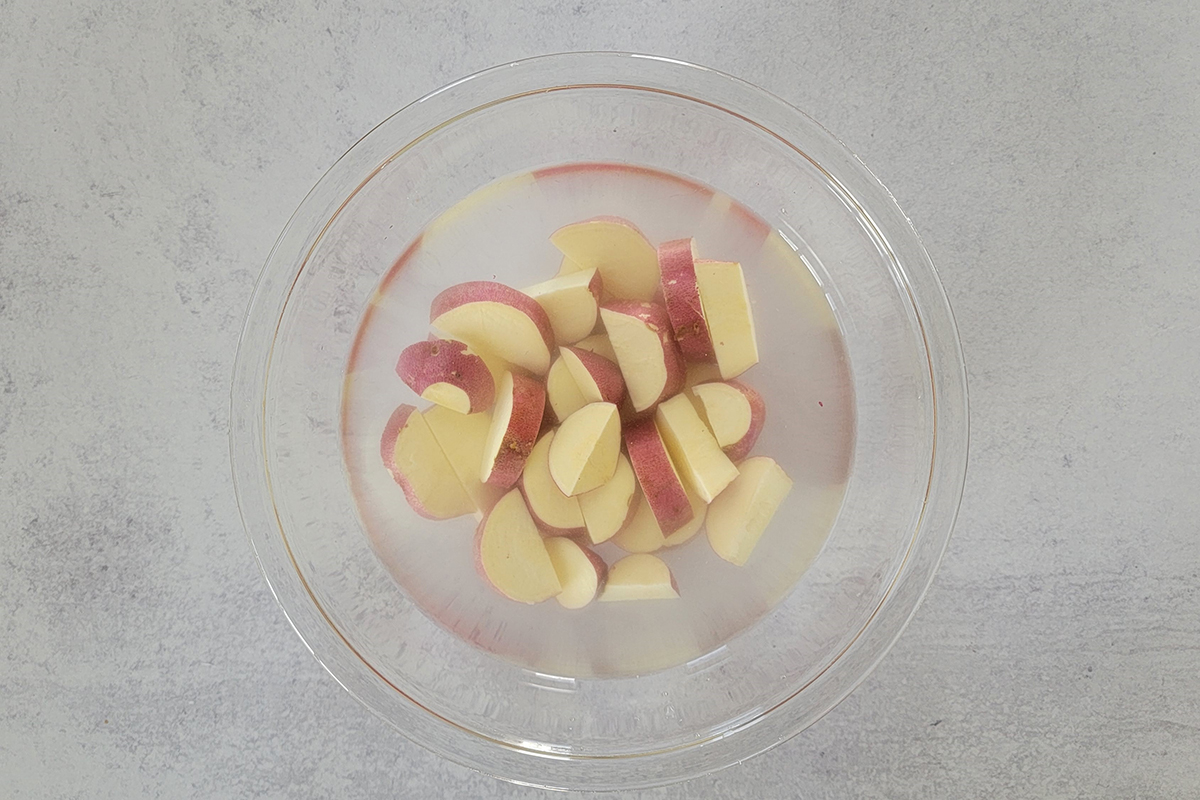
2. Meanwhile, prepare the onion and scallions. Set it aside. (miso is also shown in the photo below.)
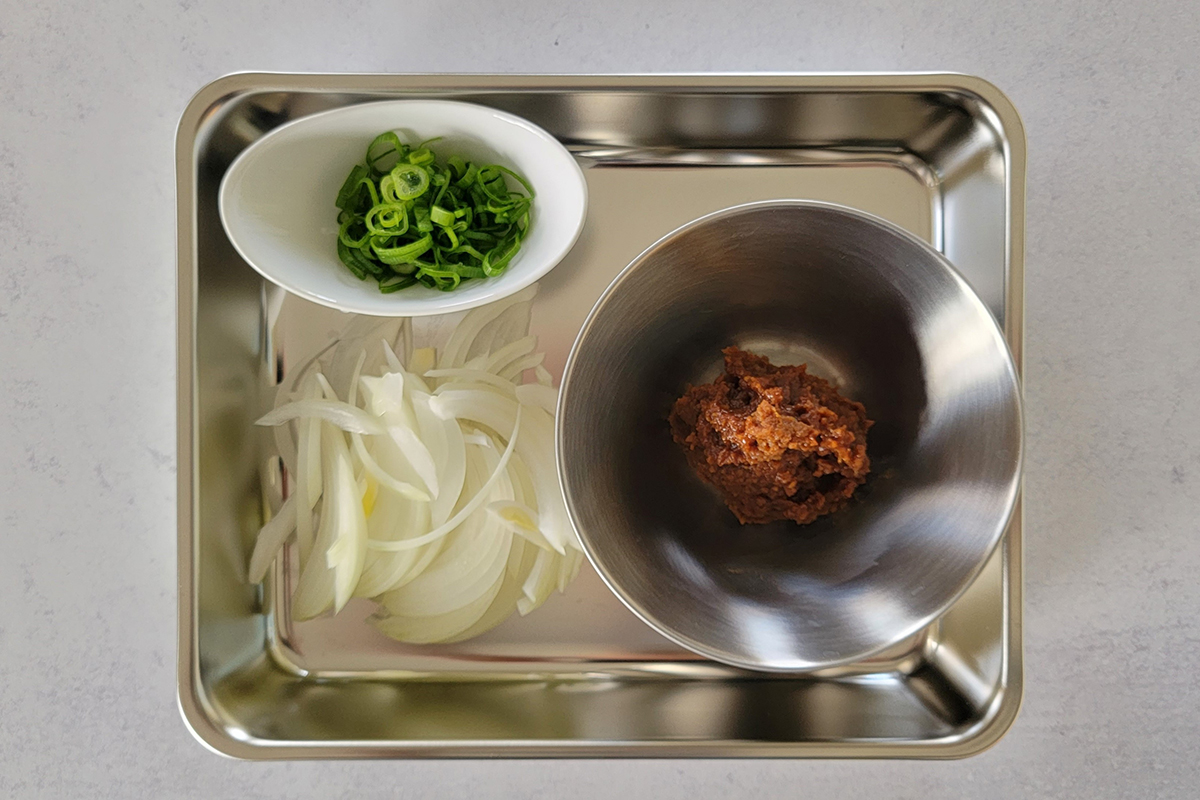
3. After the soaking, drain to discard the water.
In a medium sauce pan, combine purified water, drained Japanese sweet potatoes, and onion.
Cover and cook over medium to medium-high heat until a gentle boil.
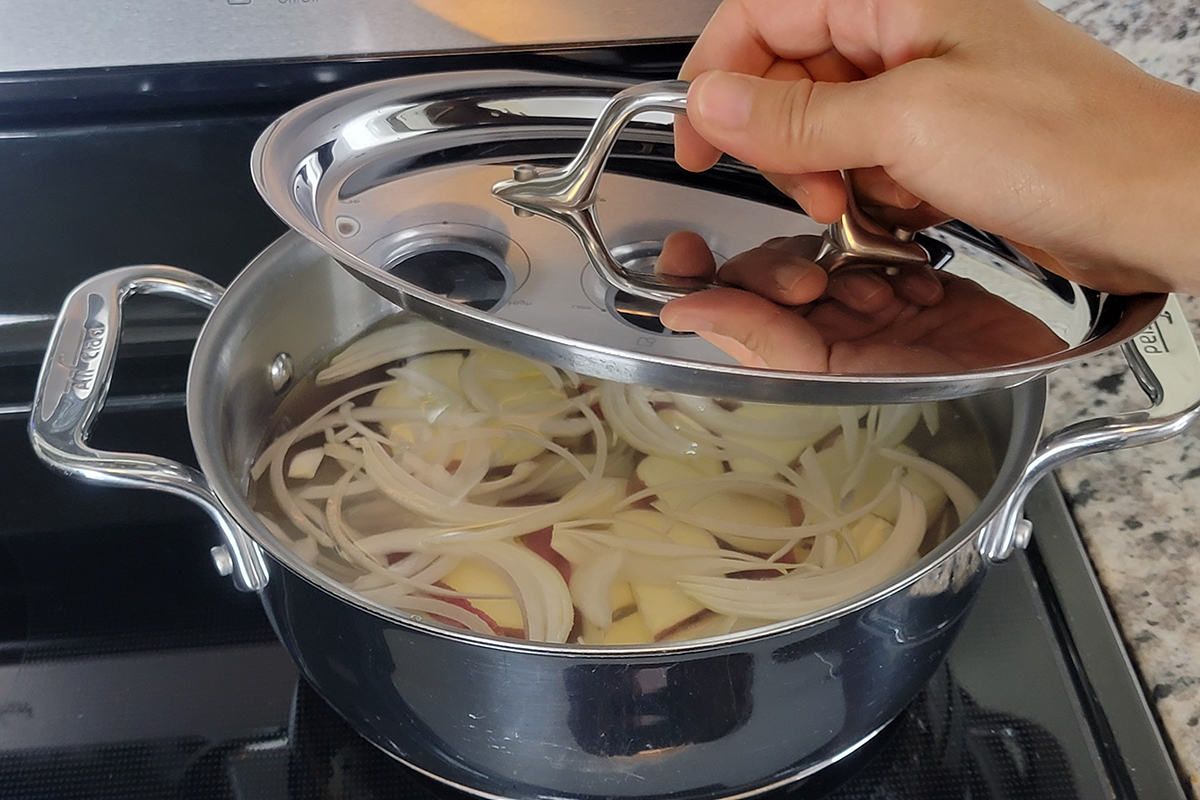
4. When it’s almost boiling, reduce the heat to medium low. Continue to simmer until potatoes are fully cooked, soft, but not broken down. You can stick a skewer (or a toothpick) to check the doneness.
5. Turn off the heat. Add miso to the soup. To do this, place the miso on a ladle then partially submerge the ladle in the soup. Use chopsticks to slowly incorporate the cooking water into the ladle so miso can dissolve.
6. Turn the heat back on at medium to medium high to reheat it (never boil!)
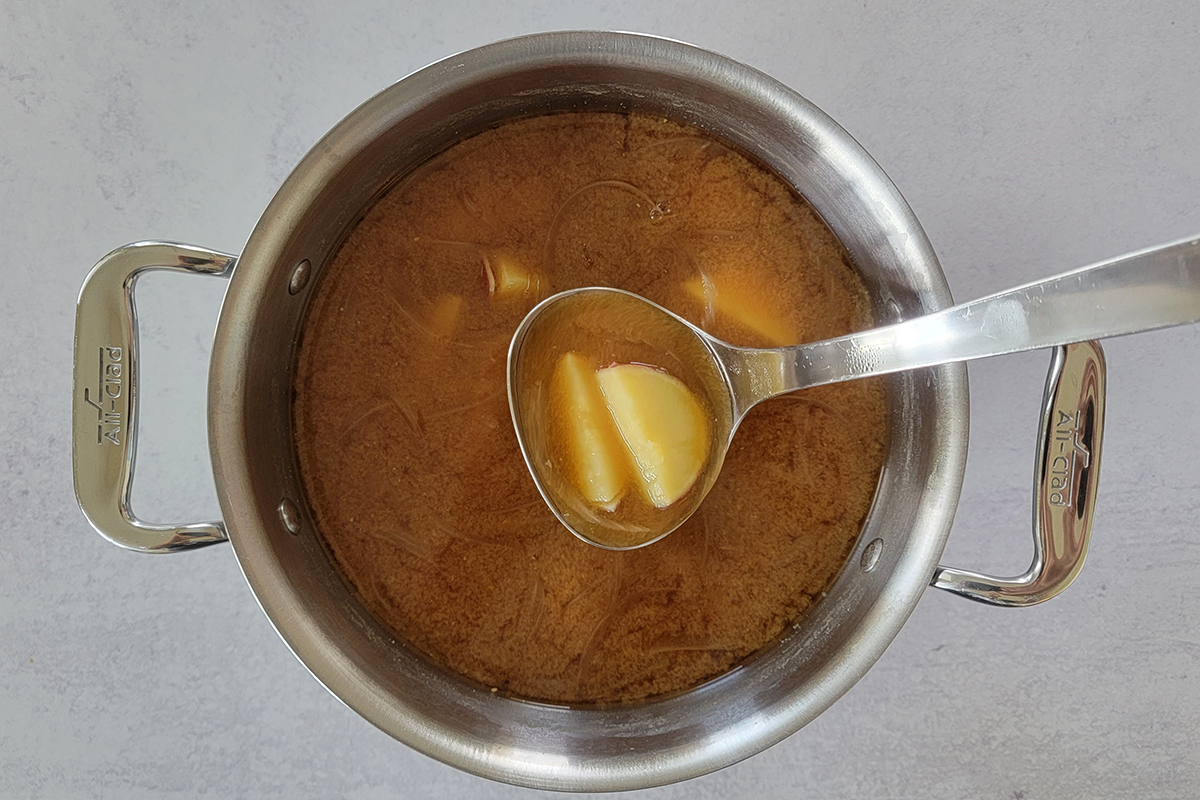
7. Serve with scallions on top. Sprinkle some shichimi pepper for some aromatic heat (optional.)
If you enjoy the recipe, please share, leave a comment below and tag us @plantbased_matters on Instagram! We appreciate your kind support 🙂
